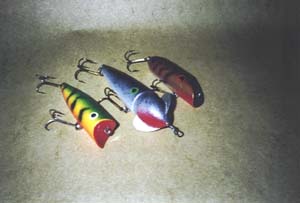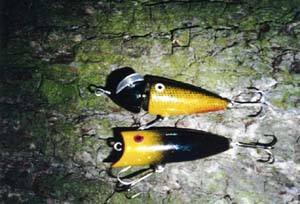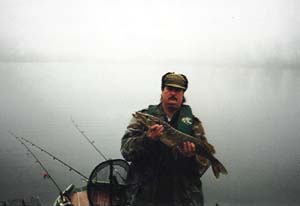

 A few years ago I started searching for other lurefishing methods and lures that were different from the ones that are widely used in Germany like spoons, spinners, crankbaits and plastic shads. Being an enthousiastic DIY-lurebuilder, whom has made hundreds of spoons and spinners and some crankbaits over the past 10 years, I started to carve out my first wooden jerkbaits and surface lures. Usually they were copies of lures I found in books and in catalogs.
A few years ago I started searching for other lurefishing methods and lures that were different from the ones that are widely used in Germany like spoons, spinners, crankbaits and plastic shads. Being an enthousiastic DIY-lurebuilder, whom has made hundreds of spoons and spinners and some crankbaits over the past 10 years, I started to carve out my first wooden jerkbaits and surface lures. Usually they were copies of lures I found in books and in catalogs.
These first surface lures ranged in length between 15cm and 25cm, just like the musky lures I copied. After having had little success with these large baseball bat kind of lures, I turned to building various copies of antique US lures, mainly surface lures copied from books that I mailordered in the States and in the UK. I was just curious about the action and the catching ability for European pike, because most of these lures were designed for bass-fishing. Some even for musky. These lures were smaller than my first baits, only 8-13cm long, and they could therefore be fished with average tackle. After two summers of trial and error with almost 2 dozen of different lures, I started to have some success with a few of these baits. Some even prooved themselves excellent pike lures.
 In one of the books I bought in The States, "The Book of Lures" by Charles K. Fox from 1975, the type of lures that prooved successful for me were described as skim-and-swim lures. This term refers to the ability to fish the lures on the surface (skim) and subsurface (swim). Both ways of lure action have to be imparted by the angler by means of rod manipulation and/or a difference in the speed of retrieving lures. A constant mixture of these two features has proven to be extremely successful for me for pike. And not only in small, shallow drains but also on some of the bigger lakes I fish on spots like sharp drop-offs from shallow to deep water, reeds along the shoreline, lillypad fields, submerged trees, ...
In one of the books I bought in The States, "The Book of Lures" by Charles K. Fox from 1975, the type of lures that prooved successful for me were described as skim-and-swim lures. This term refers to the ability to fish the lures on the surface (skim) and subsurface (swim). Both ways of lure action have to be imparted by the angler by means of rod manipulation and/or a difference in the speed of retrieving lures. A constant mixture of these two features has proven to be extremely successful for me for pike. And not only in small, shallow drains but also on some of the bigger lakes I fish on spots like sharp drop-offs from shallow to deep water, reeds along the shoreline, lillypad fields, submerged trees, ...
My favourite skim-and-swim type lures are the whirlygig, the lucky 13 and the bass oreno, even though there are some others I like as well. The latter two are still available in tackle shops or you can mailorder these in the States or in the UK.
The whirlygig was never commercialized. It has been designed and handmade by a group of anglers from Pennsylvania back in the 1940's and must therefore be handmade nowadays. They are really worth the effort though for the DIY enthousiast. They aren't as easy to build as the bass oreno or the lucky 13. Fished on a short 0.5mm diameter trace and a 6-8foot long rod, the whirlygig can be fished walk-the-dog on the surface and it can be made to dive to 1foot or 1.5 foot deep with a little tailwiggle by fast reeling. Once submerged, use a "wild dancing action" by constantly twitching the bait with the rodtip.
The Lucky 13 should be fished with a little jerk, allowing the lure to create a popping sound on the surface. Then reel it in 6-12 feet. This makes the lure dive to 1foot or 1.5 foot deep with a very irregular tail wiggle. Occasionally it creates a nice trail of airbubbles, like a torpedo does. After you let it float back up to the surface, the jerk and crank action should be repeated throughout the cast. I believe this action seems to attract pike who come to see what all the commotion is about. I once fished a small, shallow bay for about 20 minutes with a lucky 13, covering every inch of the water. Still a pike of 65cm only grabbed the lure after it had passed that same spot at least two times before. it hit.
 The bass oreno has one special feature, when comparing it to the other baits, namely it almost pops back up to it's original position after being jerked under the surface. This lure action is particularly useful to tease a pike to strike when you've located it. It can also be used to throughly check likely holding spots. On a steady retrieve the bass oreno has a nice irregular tailwiggle and it runs to about 1foot deep. The whirlygig and the bass oreno are better suited for calm water or a light chop. The lucky 13 should be used when conditions are a bit rougher. I think the loud popping sounds make scare the pike off when the water is too calm.
The bass oreno has one special feature, when comparing it to the other baits, namely it almost pops back up to it's original position after being jerked under the surface. This lure action is particularly useful to tease a pike to strike when you've located it. It can also be used to throughly check likely holding spots. On a steady retrieve the bass oreno has a nice irregular tailwiggle and it runs to about 1foot deep. The whirlygig and the bass oreno are better suited for calm water or a light chop. The lucky 13 should be used when conditions are a bit rougher. I think the loud popping sounds make scare the pike off when the water is too calm.
I fish these lures in legnths of 8-10cm long and I'm fully convinced they work. They have given me some very nice pike-catching memories and even some scary, heart-stopping strikes. I can truely say that in the warm season skim-and-swim lures are always my first choice. Even when the temperature starts to drop in autumn, skim-ad-swim fishing is still sucessful in shallow, smaller waters where pike migrate to the deeper holes. Some of these waters are shallow drains like in the Polders in The Netherlands and parts of Northern Germany.
But the key thing to remember, is that only a constant mixture of the lure action possibilities will give you the best results. This is skim-and-swim fishing! Fancy a try?
Tight lines,
Dieter maiberg
I'm sorry to say that I don't have access to the internet. This little essay has been typed on the computer after my letter by a friend, Mr Dirk Van Nieuwenhove from Belgium. If you wish to know more about this way of fishing or about the lures I use, don't hesitate to write me or call me. I speak English and German fluently.
Dieter Maiberg
E-mail : diemai@t-online.de


 A few years ago I started searching for other lurefishing methods and lures that were different from the ones that are widely used in Germany like spoons, spinners, crankbaits and plastic shads. Being an enthousiastic DIY-lurebuilder, whom has made hundreds of spoons and spinners and some crankbaits over the past 10 years, I started to carve out my first wooden jerkbaits and surface lures. Usually they were copies of lures I found in books and in catalogs.
A few years ago I started searching for other lurefishing methods and lures that were different from the ones that are widely used in Germany like spoons, spinners, crankbaits and plastic shads. Being an enthousiastic DIY-lurebuilder, whom has made hundreds of spoons and spinners and some crankbaits over the past 10 years, I started to carve out my first wooden jerkbaits and surface lures. Usually they were copies of lures I found in books and in catalogs.
 In one of the books I bought in The States, "The Book of Lures" by Charles K. Fox from 1975, the type of lures that prooved successful for me were described as skim-and-swim lures. This term refers to the ability to fish the lures on the surface (skim) and subsurface (swim). Both ways of lure action have to be imparted by the angler by means of rod manipulation and/or a difference in the speed of retrieving lures. A constant mixture of these two features has proven to be extremely successful for me for pike. And not only in small, shallow drains but also on some of the bigger lakes I fish on spots like sharp drop-offs from shallow to deep water, reeds along the shoreline, lillypad fields, submerged trees, ...
In one of the books I bought in The States, "The Book of Lures" by Charles K. Fox from 1975, the type of lures that prooved successful for me were described as skim-and-swim lures. This term refers to the ability to fish the lures on the surface (skim) and subsurface (swim). Both ways of lure action have to be imparted by the angler by means of rod manipulation and/or a difference in the speed of retrieving lures. A constant mixture of these two features has proven to be extremely successful for me for pike. And not only in small, shallow drains but also on some of the bigger lakes I fish on spots like sharp drop-offs from shallow to deep water, reeds along the shoreline, lillypad fields, submerged trees, ...
 The bass oreno has one special feature, when comparing it to the other baits, namely it almost pops back up to it's original position after being jerked under the surface. This lure action is particularly useful to tease a pike to strike when you've located it. It can also be used to throughly check likely holding spots. On a steady retrieve the bass oreno has a nice irregular tailwiggle and it runs to about 1foot deep. The whirlygig and the bass oreno are better suited for calm water or a light chop. The lucky 13 should be used when conditions are a bit rougher. I think the loud popping sounds make scare the pike off when the water is too calm.
The bass oreno has one special feature, when comparing it to the other baits, namely it almost pops back up to it's original position after being jerked under the surface. This lure action is particularly useful to tease a pike to strike when you've located it. It can also be used to throughly check likely holding spots. On a steady retrieve the bass oreno has a nice irregular tailwiggle and it runs to about 1foot deep. The whirlygig and the bass oreno are better suited for calm water or a light chop. The lucky 13 should be used when conditions are a bit rougher. I think the loud popping sounds make scare the pike off when the water is too calm.